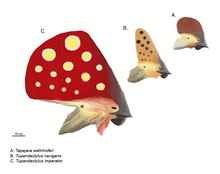Tupandactylus
Tupandactylus (meaning "Tupan finger", in reference to the Tupi thunder god) is a genus of tapejarid pterodactyloid pterosaur from the Early Cretaceous Crato Formation of Brazil.
Tupandactylus imperator is known from four nearly complete skulls. The holotype specimen is MCT 1622-R, a skull and partial lower jaw, found in the Crato Formation, dating to the boundary of the Aptian-Albian stages of the early Cretaceous period, about 112 Ma ago.[1] It was initially described as a species of Tapejara,[2] but later research has indicated it warrants its own genus. The skull was toothless and had a prominent sagittal crest, only the base of which was bony: the front of the crest featured a tall bony rod extending up and back, and the rear of the crest had a long prong of bone projecting behind it. The bulk of the crest was made up of soft tissue similar to keratin, supported by the two bony struts.[3] An additional skull described in 2011, specimen CPCA 3590, preserved more of the lower jaw, showing that like Tapejara, T. imperator had a large, asymmetrical "keel"-like crest on the underside of the lower jaw tip.
A 2021 study describing a very complete T. navigans specimen suggested that the two species might represent different sexes of one sexually dimorphic species, but cautioned that further study was needed to test this.[4]
Tupandactylus is notable for its large cranial crest, composed partly of bone and partly of soft tissue. The genus Tupandactylus possibly contains two species, both bearing differently sized/shaped crests that may have been used to signal and display for other Tupandactylus, much as toucans use their bright bills to signal to one another.
Tupandactylus crests consisted of a semicircular crest over the snout, and in the case of the type species T. imperator, a bony prong which extended back behind the head. A second species, T. navigans, lacked this prong, and had a much more vertical crest.
Soft tissue impressions also show that the small bony crests were extended by a much larger structure made of a keratinous material. The complete crest of T. navigans rose in a sharp, sail-like "dome" high above the rest of the skull.




